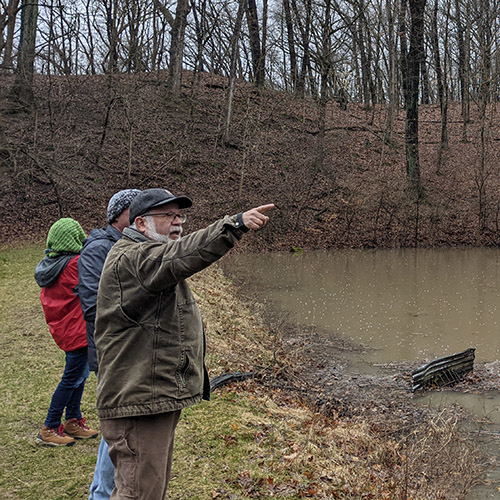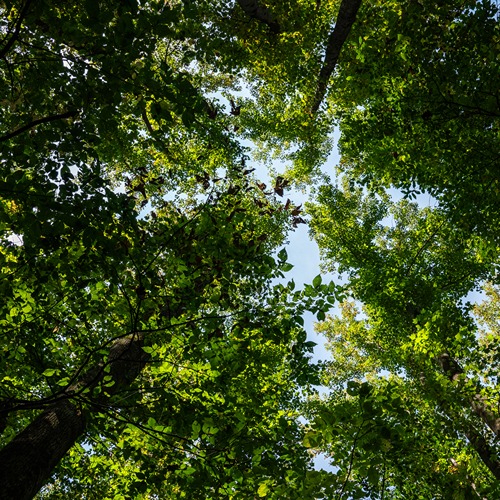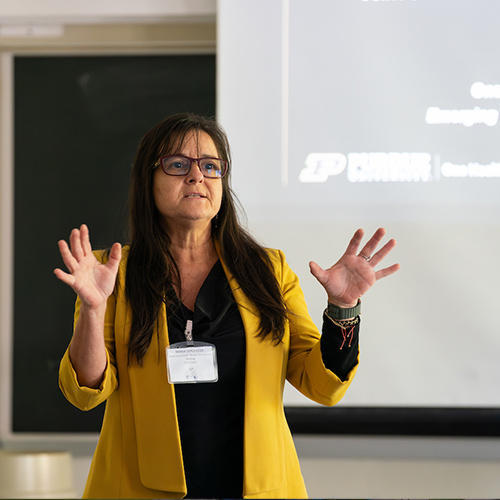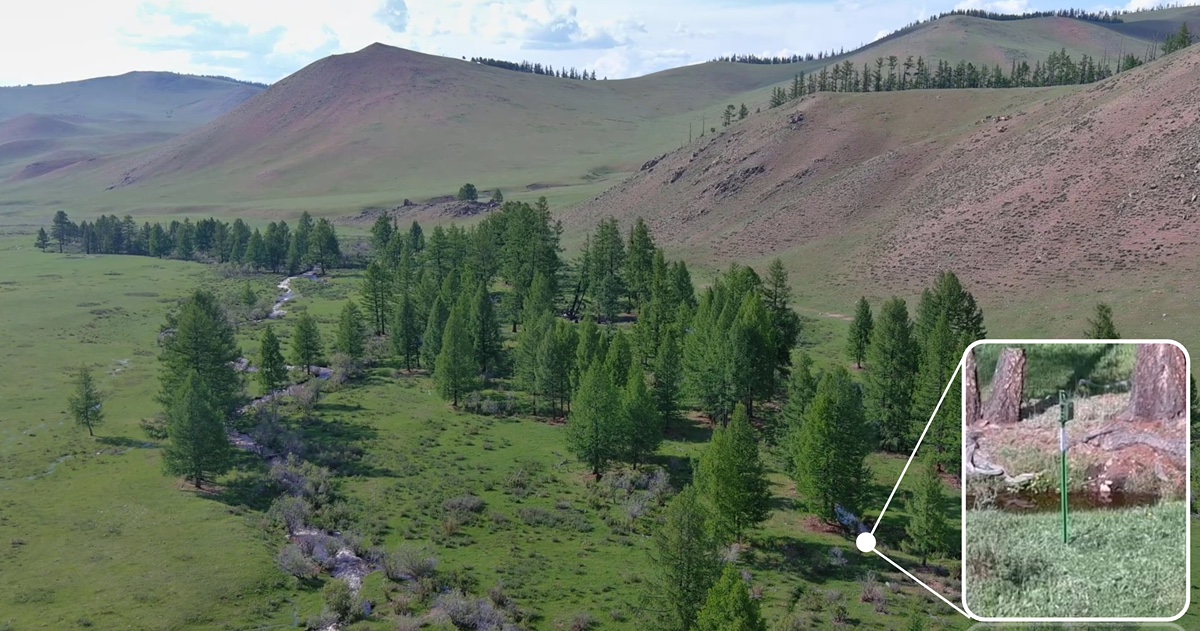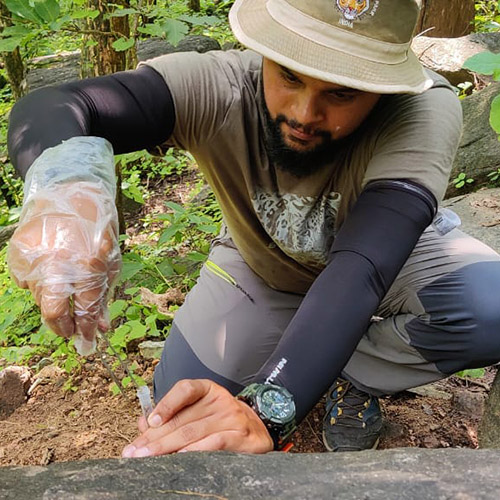Meet FNR Outstanding Transfer Student Emma Johnson
Emma Johnson transferred to Purdue after earning her associate’s degree and graduating with honors from Ivy Tech Community College. Since then, she has made Purdue Forestry and Natural Resources her home through student organization involvement and undergraduate research. For her efforts, Emma has been selected as FNR’s Outstanding Transfer Student for 2024-25. She also has been named as the Purdue College of Agriculture’s Outstanding Transfer Student.
Ivy Tech Community College. Since then, she has made Purdue Forestry and Natural Resources her home through student organization involvement and undergraduate research. For her efforts, Emma has been selected as FNR’s Outstanding Transfer Student for 2024-25. She also has been named as the Purdue College of Agriculture’s Outstanding Transfer Student.
“To me, this award means the culmination of my undergrad career,” Johnson said. “When you are in it, you sometimes forget just everything you are doing! During undergrad, I was managing FNR Flight Crew, spending long nights in a small plane, researching the effects of flying a faster plane for deer surveys and serving as an officer for TWS on top of just being a student. All of this was exhausting, but this work brought me real joy and fulfillment.
“Receiving this award is extra meaningful to me as a transfer student because I represent my transfer student community of ambitious students who have had to overcome barriers that traditional students may not have. I feel honored. I hope my winning this award inspires other transfer students in the FNR program to not hold back during their time here and to have the audacity to go after everything that they want. I hope that every transfer student feels a part of the Purdue family and knows that they deserve to be here. If you had told me a few years ago when I was going to community college and working full time that I would be where I am today, I would have laughed. I am glad that I am not laughing and that this is all real!”
Emma, who completed her bachelor’s degree in wildlife in the fall of 2024, is now in her first semester as a master’s degree student under Dr. Pat Zollner. Her research is a continuation of her undergraduate work on Indiana wildlife aerial surveys.
After arriving on campus at Purdue, Emma joined the student chapter of The Wildlife Society, for which she acted as FNR Student Council representative from May 2023 to August 2024. Through TWS, she gained experience tagging species in trail camera photos for the Snapshot USA 2022 project, assisted with bird banding days and presented animal tracks, skulls and pelts at outreach events.
In January 2025, Emma was elected as the graduate student representative for the North Central Section of The Wildlife Society. In that role, she presents all graduate students of TWS from Illinois, Indiana, Iowa, Michigan, Minnesota, Missouri, Ohio and Wisconsin. She posts on the group’s Instagram to assist current students and recent graduates find jobs and advocates for students at the section and national meetings. She has pushed to increase student involvement at the state and section level and introduce various student chapters within the state to one another. She also petitioned the Indiana State TWS Chapter Council to include a student representative position among its membership, which was approved.
The Luray, Virginia, native also joined the Purdue Student Chapter of Environmental Education (SCEE), acting as secretary and student council representative from May 2023 to August 2024. Her involvement in SCEE included presenting nature-related STEM (Science, Technology, Engineering and Mathematics) materials, such as macroinvertebrate sampling and biodiversity education, to school groups during Environmental Discover Days and other Purdue and College of Agriculture outreach events.
Outside of FNR clubs, Emma has spent her time digging into research. After previous stints as a volunteer zookeeper at Columbian Park Zoo and a volunteer on prescribed burns for Niches Land Trust, Johnson joined Dr. Barny Dunning’s songbird banding lab, gathering with other students every other Sunday morning to set up mist nets to catch and measure songbirds for the national bird banding database.
Emma also worked under Dr. Elizabeth Flaherty, tagging animal species such as white-tailed deer, Bryant’s fox squirrels, eastern gray squirrels, northern raccoons and coyote using Wildlife Insights software. Photos were captured on trail cameras at Richard G. Lugar Forestry Farm.
fox squirrels, eastern gray squirrels, northern raccoons and coyote using Wildlife Insights software. Photos were captured on trail cameras at Richard G. Lugar Forestry Farm.
In June 2023, Emma began her work with Zollner’s lab under PhD student Jonathan Brooks as an independent researcher on an Indiana Wildlife Aerial Surveys project, which aimed to evaluate the influence of flight speed on bias and precision of white-tailed deer aerial surveys. Since then, she also has been a part of the FNR flight crew for a collaborative project with the Indiana Department of Natural Resources, which looks to estimate white-tailed deer density across the state of Indiana, including some areas where epizootic hemorrhagic disease (EHD) outbreaks have occurred. Since the spring of 2024, Emma has served as the crew leader of a group of 13 undergraduate students on the Indiana DNR flight crew, which collects data for the project by operating an infrared camera from aboard a Sky Arrow aircraft. In her role of research supervisor and flight crew lead, Emma managed the flights, trained techs to operate the camera and score IR imagery, downloaded GIS and imagery data and managed and analyzed all data from the project.
Emma has presented her research with oral presentations at the 2024 and 2025 Indiana Chapter of The Wildlife Society Conference as well as at the 2024 national TWS conference in Baltimore Maryland. Her talk “Influence of aircraft flight speed on bias and precision of white-tailed deer aerial surveys” won best flash talk at the 2024 Indiana TWS conference.
Wildlife Society Conference as well as at the 2024 national TWS conference in Baltimore Maryland. Her talk “Influence of aircraft flight speed on bias and precision of white-tailed deer aerial surveys” won best flash talk at the 2024 Indiana TWS conference.
Posters regarding her work also were displayed at the 2024 FNR Poster Symposium and the 2024 Midwest Fish and Wildlife Conference in Sioux Falls, South Dakota.
In January 2025, she transitioned from undergraduate researcher to master’s degree student. Her project in the Zollner lab will build on her previous studies. Her goals are to estimate state-wide deer density over multiple years and create a long-term monitoring model of white-tailed deer populations. This will help biologists understand population recovery post-EHD outbreak and also allow them to count the current population. The second goal of her research is to evaluate the feasibility of using a crewed aircraft with infrared sensors to estimate turkey and coyote populations. She will test out different camera sensors on the crewed light-sport aircraft to best detect the species and also aims to conduct an analysis for the Indiana DNR on the most cost-effective aerial surveys for deer, coyote and turkeys.
“Emma has been the most impactful and successful transfer student I have interacted with,” Zollner said. “Essentially, she operated at the level of a graduate student developing her own research project while getting excellent grades in a rigorous upper-level undergraduate class load and engaging with the broader community of FNR students in many ways. In short, she worked super hard in lots of ways to make FNR and our larger community better, while also advancing her own professional preparation. There is no better evidence of her dedication and skill then me keeping her in my lab as a graduate student after her BS. I can’t imagine anyone better suited for this award than Emma.”
In addition to on-campus research, Emma has also spent her summers getting hands-on experience in the field through a variety of internships and positions.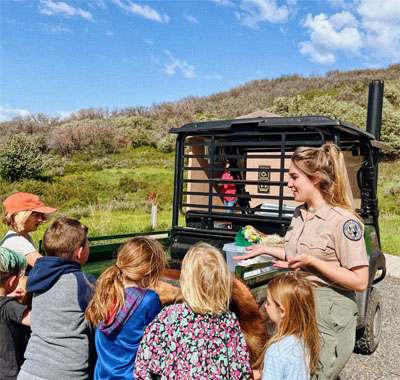
In 2022, Emma went to Collbran, Colorado, where she worked as an interpretive park ranger and aquatic nuisance species inspector for Colorado Parks and Wildlife. Emma worked with another intern to lead Vega State Park’s nature interpretation programs, presenting programs at the campgrounds, educating young campers and their families and also presenting educational materials at a local library. In addition, she inspected boats for aquatic nuisance species after learning how to identify species like zebra and quagga mussels in all of their stages and how to decontaminate watercraft infected with them.
In 2022 and 2023, Johnson was a wildlife extension technician for Purdue FNR under Purdue Extension wildlife specialist Jarred Brooke. As a sophomore, Emma conducted pellet count surveys and measured browse impacts of deer on vegetation to estimate white-tailed deer density at Martell Forest. The following year, she deployed and retrieved trail cameras, tagged species and added them to the Wildlife Insights database. She conducted point count surveys for game birds, conducted grassland surveys on Purdue FNR properties and sampled native prairie grasses, planted forbs and treated experimental goldenrod plots from broadcast application of herbicide from a UTV to moving from a tractor. Emma also presented wildlife education materials at youth summer camps, including specimen ID, scent station instructions and mammal track workshops.
education materials at youth summer camps, including specimen ID, scent station instructions and mammal track workshops.
Emma spent the summer of 2024 as a Pronghorn Pro Technician for Oklahoma State University’s Oklahoma Pronghorn project in the panhandle of the state. In her position, Johnson used radio telemetry to track collared pronghorn does and observe them to check pregnancy status and subsequently capture, process and collar fawns to track fawn survival. She also observed pronghorn behavior during drone surveys, conducted fecal pellet samples from adults and performed field necropsies on deceased pronghorns to investigate the cause for their mortality, including taking tissue samples to test for diseases.
In the classroom, Johnson has acted as teaching assistant for the Systematics and Ecology of Fish and Herps Lab.


